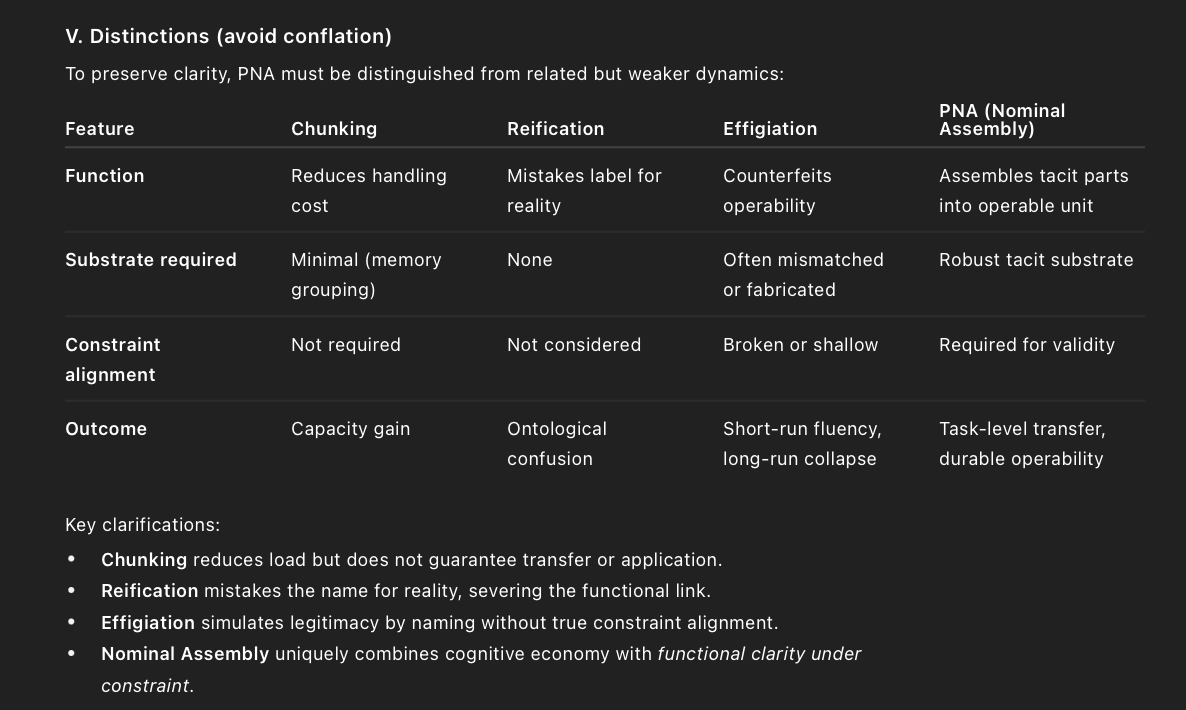This appendix introduces the Principle of Nominal Assembly (PNA), which explains how tacitly apprehended patterns become symbolically operable through naming. While ontological prerogatives determine what can be instantiated, and semiotic codes explain how meaning is conveyed, the PNA addresses a subtler but critical threshold: the moment when diffuse tacit links consolidate into a functional whole by means of a signifier.
Its placement here—under Semiotics—reflects its role as a micro-mechanism of symbolic economy. Nominalization not only compresses cognitive load but also assembles free-floating components into a system capable of transfer and application. In this sense, PNA serves as a bridge: from tacit cognition (substrate) to explicit semiotic deployment (discourse). It cross-references Ontology (valid vs. counterfeit instantiation), Pragmatics (deixis and implicature), and the Onto-Discursive Analysis tool (diagnosing how terms crystallize diffuse material into functional discourse).
Cross-References
The Principle of Nominal Assembly should be read alongside the
Semiotics section
(where codes, tropes, and typophora are treated as broader mechanisms of meaning-assembly), the Onto-Discursive Analysis (ODA) tool
(where PNA functions as a diagnostic checkpoint under the Pragmatic Implication and Structural Framing layers), and the
Naming vs. Ambiguity essay on how disambiguation collapses manipulative mystique (which provides the adjudicative counterweight to assembly by exposing counterfeit or manipulative uses of ambiguity). Together these strands form the foundation of
Claritics
, the discipline of ontological disambiguation.
Principle of Nominal Assembly (PNA).
Nominalization not only economizes cognition but also assembles tacitly free-floating components into a functional whole. The naming moment is an assembly threshold: what was diffuse becomes constraint-consistent, task-transferable, and operable—presupposing, but never exhausting, its tacit substrate.
Nominalization is thus necessary but not sufficient for functional clarity. True assembly requires coherence between three elements:
the label (signifier),
the tacit substrate (content already grasped, though not fully articulated), and
the task constraints (which determine whether the assembled unit genuinely functions).
Where these three converge, the result is more than shorthand: it is the transformation of parts into a system ready for application, teaching, and transfer.
Operability – the capacity of the assembled unit to yield correct, transferable action under constraint; the distinction between inert recognition and functional application.
Assembly threshold – the snap-fit moment when label, tacit substrate, and task constraints align, transforming diffuse content into a functional whole.
Scope. The PNA applies to conceptual learning, note-taking, symbolic framing, narrative construction, and typophoric reference. It clarifies why naming often yields a “light-bulb” moment: not because it creates new knowledge, but because it configures tacitly present material into a usable, constraint-consistent unit.
The Principle of Nominal Assembly sits in continuity with earlier insights but introduces its own refinement: operability under constraint.
Michael Polanyi highlighted the irreducible primacy of tacit knowledge (“we can know more than we can tell”). The PNA extends his insight by describing how tacit patterns become functional once named.
Gestalt psychology (Köhler, Wertheimer) analyzed the “aha” moment of insight as a perceptual reconfiguration. PNA parallels this but emphasizes symbolic and pragmatic operability rather than perception alone.
Peircean semiotics described meaning as a triadic relation of sign, object, and interpretant. PNA builds on this, distinguishing empty labels from true assemblies: only when tacit substrate and task constraints are aligned does nominalization achieve functional clarity.
Thomas Kuhn observed that scientific paradigms shift when anomalies force a gestalt switch; the same data suddenly “fits.” PNA mirrors this dynamic but at the scale of everyday cognition and discourse.
Distinctive contribution: Whereas these traditions describe perception, tacit grounding, or semiotic relation, the PNA specifies the assembly threshold—the point at which naming consolidates tacit components into a transferable, constraint-consistent tool.

Nominal assembly unfolds through a four-stage process:
Pre-threshold (diffuse coherence): Tacit links are sensed but cannot yet be stabilized. The elements exist as free-floating impressions without operability.
Trigger (nominal act): A label or phrase anchors the diffuse content, applying boundaries and constraint.
Snap-fit (assembly): Label, tacit substrate, and task constraints lock together. The system now performs with lower error and latency than before, yielding constraint-consistent compression.
Post-threshold (functional clarity): The assembled unit is lighter to carry, portable across contexts, and task-transferable. It can be taught, tested, and adapted, functioning as a genuine tool rather than an inert set of parts.
This mechanism clarifies the light-bulb moment: what feels like sudden discovery is not the appearance of new knowledge but the assembly of tacitly present components into a usable, constraint-consistent whole.
The Principle of Nominal Assembly is visible across fields whenever diffuse elements “snap” into operability:
Jigsaw → Picture: The pieces already exist, but once assembled and named as a landscape or a portrait, they cohere into a functional unit for recognition, description, and transfer.
Rifle parts → Rifle: A stock, barrel, and trigger are inert separately. Assembly transforms them into a system capable of discharge. Naming consolidates not only the parts but their relational purpose under constraint.
Mathematics: The introduction of “invariant” does not invent invariance, but crystallizes scattered results into a transferable tool. The label assembles disparate examples into a constraint-bound category with predictive leverage.
Clinical medicine: Diffuse symptoms—when named as a syndrome—become an actionable pathway. Constraint is applied not only by inclusion criteria (what counts) but by exclusion (what must be ruled out).
Executive communication: A coined frame such as “Reliability Gap” integrates diffuse concerns (missed deadlines, inconsistent updates, opaque reporting) into a single actionable concept. The label assembles parts into a metric-bound tool for accountability.
Biblical typophora: “Lamb of God” crystallizes diffuse anticipations into a functional referent that anchors meaning, secures typological continuity, and enables faithful interpretation across texts.
The PNA contributes at several junctions of the Submetaphysics framework:
Semiotics (codes and tropes): Nominalization acts as the micro-mechanism by which codes compress and transmit meaning.
Typophora: Assembly stabilizes type-reference, though counterfeit assemblies can simulate stability. This reinforces the need to test assemblies against ontological ground.
Pragmatics: Once assembled, a unit becomes deployable in deixis and implicature. PNA thus explains why coined terms carry immediate rhetorical force.
Ontology: PNA mirrors instantiation at the micro-level: parts become a functional whole, but only when assembled under valid constraint. This echoes the distinction between exempliatio fidelis and effigiation.
ODA Tool: PNA can serve as a diagnostic checkpoint under the Pragmatic Implication and Structural Framing layers, exposing whether discourse genuinely assembles tacit material or merely simulates clarity.
In each case, the contribution is consistent: PNA illuminates how language does not just name, but activates, transforming latent coherence into operable clarity.
Ambiguity is fraud’s cover; naming is fidelity’s act. Where naming assembles tacit parts into an operable whole, ambiguity leaves them free-floating, exploitable, and shielded from scrutiny. From mystique to measurement, from effigiation to reality, disambiguation is the way truth is defended.
The consequences of failing to name are not merely academic—they are profound and often dire:
Medicine: Without naming a syndrome, diffuse symptoms cannot be assembled into a treatment pathway. Patients remain untreated, and pathology advances unchecked.
Law: Without naming fraud, theft, or breach, ambiguity protects the guilty and blocks justice. Legal mystique becomes a refuge for exploitation.
Governance: Without naming corruption or abuse, euphemism becomes a veil for impunity. Ambiguity allows institutions to present appearance without accountability.
Theology: Without naming idolatry or effigiation, counterfeit worship passes for faith. Ambiguity cloaks distortion with a semblance of legitimacy.
In each domain, ambiguity functions as a mask—protecting what cannot withstand exposure to clarity. Naming collapses this cover by assembling diffuse realities into functional categories that can be judged, measured, and acted upon.
Thus, the Principle of Nominal Assembly must be read in tandem with disambiguation. Naming assembles; disambiguation defends. Together they collapse mystique into clarity, transforming latent coherence into operable truth, and guarding reality from counterfeit or manipulative simulation.
Because nominalization is powerful, it is also prone to distortion:
Cargo-cult nominalization: A label is introduced without tacit substrate. The result is apparent clarity without operability—an illusion of understanding.
False assembly: Mismatched parts are forced together under a seductive term. The unit appears coherent but collapses when tested against constraint.
Manipulative framing: Actors exploit the economy of nominalization to smuggle ontological or ethical errors, bypassing scrutiny by presenting diffuse issues as a neatly assembled whole.
Over-reduction: Complex realities are compressed beyond integrity. The gain in economy comes at the expense of fidelity, producing brittle categories.
Counterfeit operability: Terms may work in the short run but fail under adversarial or shifted conditions, revealing their lack of constraint-consistent assembly.
These failure modes reinforce the necessity of testing assemblies against their substrate and constraints, rather than mistaking linguistic efficiency for truth or validity.
Applied Potential.The Principle of Nominal Assembly has wide implications beyond philosophy. It clarifies how naming crystallizes tacit knowledge into operable units, a process vital for accelerated learning, pedagogy, and the testing of narratives. Yet its use requires genuine engagement: without immersion in the tacit substrate and careful attention to constraint, naming degenerates into jargon or counterfeit clarity. Readers seeking to apply this principle must therefore work through the framework itself, not merely borrow its vocabulary.
The PNA is both a tool and a risk. To use it faithfully, assemblies must be tested against their tacit substrate, their task constraints, and their susceptibility to ambiguity. The following heuristics provide practical guardrails:
Immerse before you name.
Nominalization requires a robust tacit substrate. Without prior immersion, a label produces only the illusion of assembly.
Name to assemble, then probe.
Treat naming as a provisional snap-fit. Immediately probe for operability:
Predictive leverage: does the unit anticipate outcomes or narrow possibilities?
Transfer: does it solve tasks beyond the original context?
Compression without loss: can it be taught or applied faster without increased error?
Triad coherence (label ↔ substrate ↔ constraint).
A valid assembly requires all three. If any leg of the triad is missing, the unit is unstable or misleading.
Counter-token test.
Ask whether the unit can be disassembled and reassembled elsewhere. Robust assemblies generalize under variation; false assemblies collapse.
Economy with integrity.
Aim for faithful compression. Nominalization should lighten cognitive handling while preserving essential constraints. A label that achieves economy at the cost of truth is counterfeit.
Collapse ambiguity when encountered.
Treat ambiguity not as harmless vagueness but as potential cover for fraud or effigiation. The act of naming should cut through mystique, exposing what is otherwise hidden and forcing testable clarity.
